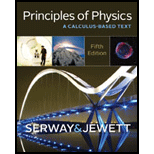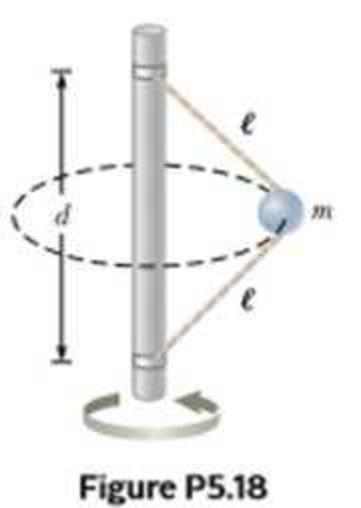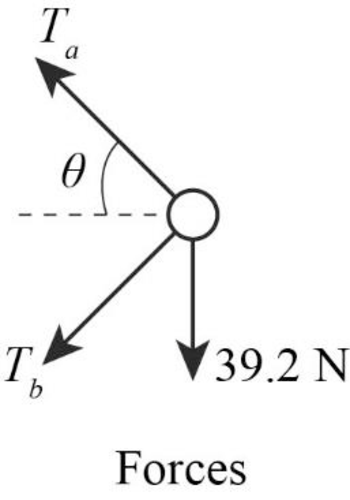
Why is the following situation impossible? The object of mass m = 4.00 kg in Figure P5.18 is attached to a vertical rod by two strings of length ℓ = 2.00 m. The strings are attached to the rod at points a distance d = 3.00 m apart. The object rotates in a horizontal circle at a constant speed of v = 3.00 m/s, and the strings remain taut. The rod rotates along with the object so that the strings do not wrap on to the rod. What If? Could this situation be possible on another planet?

The reason why the situation shown in Figure P5.18 is impossible, and whether this situation is be possible on another planet.
Answer to Problem 18P
The situation shown in Figure P5.18 is impossible, because the speed of the object is too small, the lower string is require that act like a rod and push rather than like a string and pull. This situation is only possible when
Explanation of Solution
The free body diagram of the system is shown Figure.

Write the expression for force due to gravity.
Here,
A centripetal force is needed to keep the object in the circular motion, this is equal to the force in the horizontal direction.
Here,
From the free body diagram, write the expression for net force in the
Here,
Equate equation (II) and (III).
Write the expression for force in the
Since there is no acceleration in the
From the free body diagram, write the expression for net force in the
Equate equation (V) and (VI).
Add equation (IV) and (VII).
Conclusion:
The angle
`
The radius of the orbit can be found as follows,
Substitute,
Substitute,
It indicates that lower string pushes rather than pulls.
Substitute,
Substitute,
This is possible only when
Therefore, the situation shown in Figure P5.18 is impossible, because the speed of the object is too small, the lower string is require that act like a rod and push rather than like a string and pull. This situation is only possible when
Want to see more full solutions like this?
Chapter 5 Solutions
Principles of Physics
- A single bead can slide with negligible friction on a stiff wire that has been bent into a circular loop of radius 15.0 cm as shown in Figure P5.59. The circle is always in a vertical plane and rotates steadily about its vertical diameter with a period of 0.450 s. The position of the bead is described by the angle θ that the radial line, from the center of the loop to the bead, makes with the vertical. (a) At what angle up from the bottom of the circle can the bead stay motionless relative to the turning circle? (b) What If ? Repeat the problem, this time taking the period of the circle’s rotation as 0.850 s. (c) Describe how the solution to part (b) is different from the solution to part (a). (d) For any period or loop size, is there always an angle at which the bead can stand still relative to the loop? (e) Are there ever more than two angles? Arnold Arons suggested the idea for this problem. Figure P5.59arrow_forwardA small block with mass 0.0400 kg slides in a vertical circle of radius R = 0.500 m on the inside of a circular track. During one of the revolutions of the block, when the block is at the bottom of its path, point A, the normal force exerted on the block by the track has magnitude 3.95 N. In this same revolution, when the block reaches the top of its path, point B, the normal force exerted on the block has magnitude 0.680 N. How much work is done on the block by friction during the motion of the block from point A to point B?arrow_forwardA small block with mass 0.0300 kgkg slides in a vertical circle of radius 0.425 mm on the inside of a circular track. During one of the revolutions of the block, when the block is at the bottom of its path, point AA, the magnitude of the normal force exerted on the block by the track has magnitude 3.90 NN . In this same revolution, when the block reaches the top of its path, point BB, the magnitude of the normal force exerted on the block has magnitude 0.675 NN . 1)How much work was done on the block by friction during the motion of the block from point AA to point BB?arrow_forward
- A small block with mass 0.0500 kg slides in a vertical circle of radius 0.475 m on the inside of a circular track. During one of the revolutions of the block, when the block is at the bottom of its path, point A, the magnitude of the normal force exerted on the block by the track has magnitude 3.80 N . In this same revolution, when the block reaches the top of its path, point B, the magnitude of the normal force exerted on the block has magnitude 0.665 N . How much work was done on the block by friction during the motion of the block from point A to point B?arrow_forwardOn the International Space Station an object with mass m = 170g is attached to a massless string of length L = 0.61m . The string can handle a tension of T = 8 N before breaking The object undergoes uniform circular motion, being spun around by the string horizontally What is the maximum speed v the mass can have before the string breaks ? Give your answer in units of m/sarrow_forwardA load of 52 kg is placed on the flatbed of a truck going around a section of flat road corresponding to a circular arc with a radius of 80 m. If the coefficient of static friction between the load and the truck's flatbed is 0.355, what is the maximum speed the truck can have so the load won't slide? a) 28.0 m/s b) 5.33 m/s c) 16.7 m/s d) 22.6 m/s e) 279 m/sarrow_forward
- On the International Space Station an object with mass m = 440 g is attached to a massless string of length L = 0.61 m. The string can handle a tension of T = 5.8 N before breaking. The object undergoes uniform circular motion, being spun around by the string horizontally.What is the maximum speed v the mass can have before the string breaks? Give your answer in units of m/s.arrow_forwardA new roller coaster contains a loop-the-loop in which the car and rider are completely upside down. If the radius of the loop is 13.2 with what minimum speed must the car traverse the loop so that the rider does not fall out while upside down at the top? Assume the rider is not strapped to the car. 11.4 m/s 12.5 m/s 10.1 m/s 14.9 m/sarrow_forwardA single bead can slide with negligible friction on a stiff wire that has been bent into a circular loop of radius 15.0 cm as shown in Figure P6.48. The circle is always in a vertical plane and rotates steadily about its vertical diameter with a period of 0.450 s. The position of the bead is described by the angle that the radial line, from the center of the loop to the bead, makes with the vertical. (a) At what angle up from the bottom of the circle can the bead slay motionless relative to the turning circle? (b) What If? Repeat the problem, this time taking the period of the circles rotation as 0.850 s. (c) Describe how the solution to part (b) is different from the solution to part (a). (d) For any period or loop size, is there always an angle at which the bead can stand still relative to the loop? (e) Are there ever more than two angles? Arnold Arons suggested the idea for this problem. Figure P6.48arrow_forward
- Why is the following situation impossible? A mischievous child goes to an amusement park with his family. On one ride, after a severe scolding from his mother, he slips out of his seat and climbs to the top of the rides structure, which is shaped like a cone with its axis vertical and its sloped sides making an angle of = 20.0 with the horizontal as shown in Figure P6.32. This part of the structure rotates about the vertical central axis when the ride operates. The child sits on the sloped surface at a point d = 5.32 m down the sloped side from the center of the cone and pouts. The coefficient of static friction between the boy and the cone is 0.700. The ride operator does not notice that the child has slipped away from his seat and so continues to operate the ride. As a result, the sitting, pouting boy rotates in a circular path at a speed of 3.75 m/s. Figure P6.32arrow_forwardInstead of moving back and forth, a conical pendulum moves in a circle at constant speed as its string traces out a cone (Fig. P6.68). One such pendulum is constructed with a string of length L = 12.0cm and bob of mass 0.210 kg. The string makes an angle = 7.00 with the vertical, a. What is the radial acceleration of the bob? b. What are the horizontal and vertical components of the tension force exerted by the string on the bob?arrow_forwardAn air puck of mass m1 = 0.25 kg is tied to a siring and allowed to revolve in a circle of radius R = 1.0 m on a frictionless horizontal table. The other end of the string passes through a hole in the center of the table, and a mass of m2 = 1.0 kg is tied to it (Fig. P7.27). The suspended mass remains in equilibrium while the puck on the tabletop revolves, (a) What is the tension in the string? (b) What is the horizontal force acting on the puck? (c) What is the speed of the puck? Figure P7.27arrow_forward
 Physics for Scientists and Engineers with Modern ...PhysicsISBN:9781337553292Author:Raymond A. Serway, John W. JewettPublisher:Cengage Learning
Physics for Scientists and Engineers with Modern ...PhysicsISBN:9781337553292Author:Raymond A. Serway, John W. JewettPublisher:Cengage Learning Physics for Scientists and EngineersPhysicsISBN:9781337553278Author:Raymond A. Serway, John W. JewettPublisher:Cengage Learning
Physics for Scientists and EngineersPhysicsISBN:9781337553278Author:Raymond A. Serway, John W. JewettPublisher:Cengage Learning Principles of Physics: A Calculus-Based TextPhysicsISBN:9781133104261Author:Raymond A. Serway, John W. JewettPublisher:Cengage Learning
Principles of Physics: A Calculus-Based TextPhysicsISBN:9781133104261Author:Raymond A. Serway, John W. JewettPublisher:Cengage Learning Physics for Scientists and Engineers: Foundations...PhysicsISBN:9781133939146Author:Katz, Debora M.Publisher:Cengage Learning
Physics for Scientists and Engineers: Foundations...PhysicsISBN:9781133939146Author:Katz, Debora M.Publisher:Cengage Learning College PhysicsPhysicsISBN:9781305952300Author:Raymond A. Serway, Chris VuillePublisher:Cengage Learning
College PhysicsPhysicsISBN:9781305952300Author:Raymond A. Serway, Chris VuillePublisher:Cengage Learning




